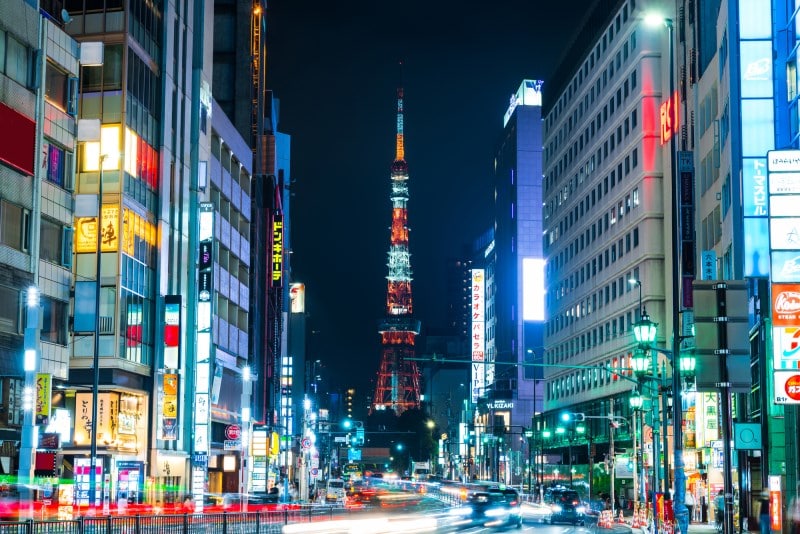Roppongi is a highly popular district in Tokyo, famous (or infamous) for its shopping, nightlife, and yes… having a ton of foreigners! But what is it that makes Roppongi so popular with tourists and immigrants? What do Japanese people think? And how easy (or hard) is it to live there?
Table of Contents
ToggleHistory
Before visitors poured in from overseas, Roppongi was an important part of the shogunate in the late Edo Period. It was home to several daimyo mansions, as well as many shrines and shops.
The name Roppongi first appeared on a map in 1878 with the establishment of the Azabu Ward. However, the first record of the city dates back to 1828, and many believe the name itself has been around much longer (as early as then 1660s).
While nobody knows for sure where the name came from, there are several theories. The name Roppongi (六本木) literally means ‘six trees’. Some believe it refers six trees that served as landmarks in the Edo Period. Others believe it refers to the six daimyo who resided there, each whose written Japanese name contained the kanji for ‘tree’ (木).
Roppongi’s First Foreign Visitors
After the Meiji Restoration, Roppongi became an army territory and was requisitioned by the US military after WWII. Then in 1954, an Italian-American man, Nick Zappetti, opened the first American pizza shop in Tokyo (which, sadly, closed its doors in 2018). This paved the way for even more Western-style businesses to flourish – specifically, nightlife entertainment.
Bars, clubs, and love hotels populated the city streets. This soon attracted more than just foreigners. Shady businesses and foreign scammers sprung up amongst the dance halls. Soon, even the yakuza established a presence. Roppongi quickly became a place that decent people avoided. But by the end of the economic bubble burst, Roppongi was hard-hit by bankruptcies. Japan saw this as a chance to rebuild and clean up the area.
Planning a trip to Japan? Get an authentic, interpreted experience from Unseen Japan Tours and see a side of the country others miss!

"Noah [at Unseen Japan] put together an itinerary that didn’t lock us in and we could travel at our own pace. In Tokyo, he guided us personally on a walking tour. Overall, he made our Japan trip an experience not to forget." - Kate and Simon S., Australia


Keep all you devices connected in Japan - rent a pocket wifi device! Available for hotel pickup or delivered to your airport. Fast speeds and backed by excellent customer service. (Note: Affiliate link - Unseen Japan earns a commission if you make a purchase.)
Several large-scale redevelopment projects over the years resulted in the establishment of some of today’s most popular attractions: Roppongi Hills, Tokyo Midtown, Akasaka Sacas, and The National Art Center, to name a few. However, this didn’t erase Roppongi’s history. While the city did indeed get a makeover, much of the nightlife (and foreigners) remained.
Foreigners in Roppongi Today
Contrary to Roppongi’s image, Roppongi doesn’t even make the top 10 Japanese wards with the most foreign residents. It actually ranks 11 out of 23 (if you’re curious, Shinjuku ranked #1).
However, Minato Ward (where Roppongi is) does rank first as the ward with the highest percentage of Western foreigners (including Europe, the Americas, and Canada). In fact, nearly 21% – one out of five – of all of Tokyo’s North American residents live in the Minato Ward.
Considering Roppongi’s history as an American military zone, it makes sense that it would gather the highest amount of English-speaking foreigners. This in and of itself has its own pros and cons.
Roppongi from a Japanese Perspective: Pros & Cons

There are indeed a number of Japanese residents who view Roppongi as nothing short of an unsafe “Gaijin Hell“. Wild, young tourists crowd shops and restaurants with no regard for manners. Obnoxious immigrants (some of whom don’t even bother to learn a lick of Japanese!) frequent the bars and clubs trying to pick up chicks. Sadly, these stereotypes have only strengthened the anti-foreigner, anti-Roppongi sentiment many Japanese people share. Add Roppongi’s past affiliation with the yakuza and other illegal doings, we can see why the older generation is not too thrilled about the area.
However, Japan’s economy does get a great boost from foreign business and tourism. Roppongi is a hub for tourists and foreign residents alike. It is also a great place to find imported goods and enjoy international cuisine. Finally, for Japanese learners of English, there are plenty of opportunities to meet English speakers and attend language exchange groups and events.
Living in Roppongi
What about actually living in Roppongi?
The average monthly rent for a small, studio-size (single-person) apartment in Roppongi is about 134,000 yen ($1,268USD), about 7,000-13,000 yen ($60-123USD) higher than neighboring areas. Even if you can afford the rent, you’ll most likely have your wallet squeezed by the general cost of living. (Shops in Roppongi are pretty expensive!)
Another thing to consider is the atmosphere. Being Japan’s most famous party town, there is also bound to be a higher crime rate in the area. From bar-front scuffles to theft to prostitution, Roppongi is one of the few areas in Japan where safety should actually be a concern. In fact, while Roppongi ranked 5/5 stars for convenience and entertainment, it only ranked 1 for security.
The Verdict
Though the elderly and family-oriented people may avoid the area, for students and young businesspeople, Roppongi can be a good place to spend the weekend. Despite the controversies, there’s plenty of entertainment, food, and shopping, even if you’re not about the nightlife. Also, being easily accessible by train, you don’t even have to live in the area!
Whether you’re from Japan or abroad, from the ocean or from outer space, there’s something to enjoy for everyone!
